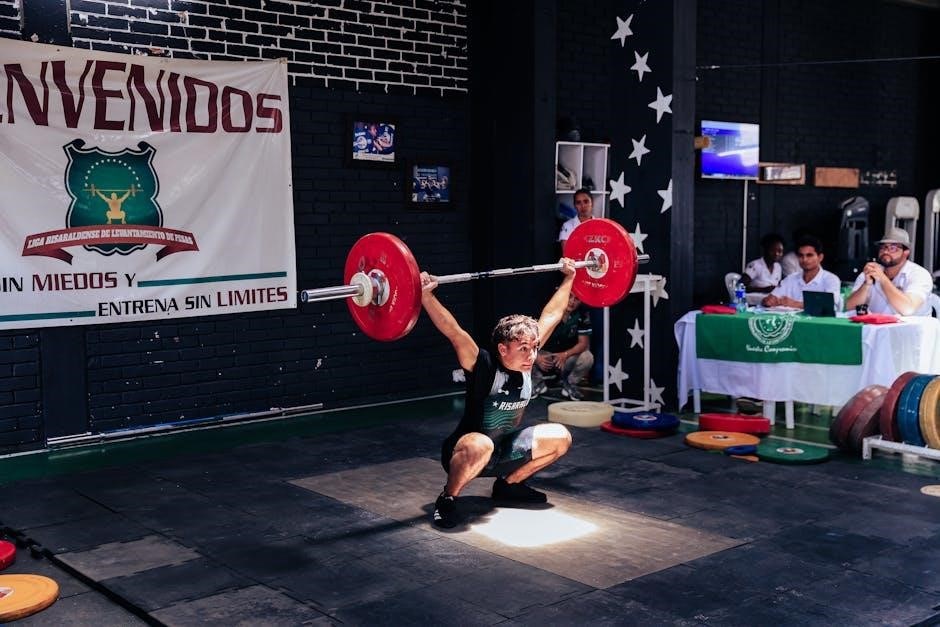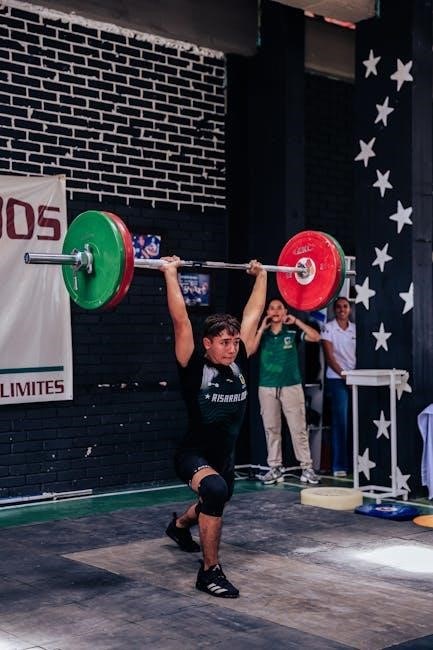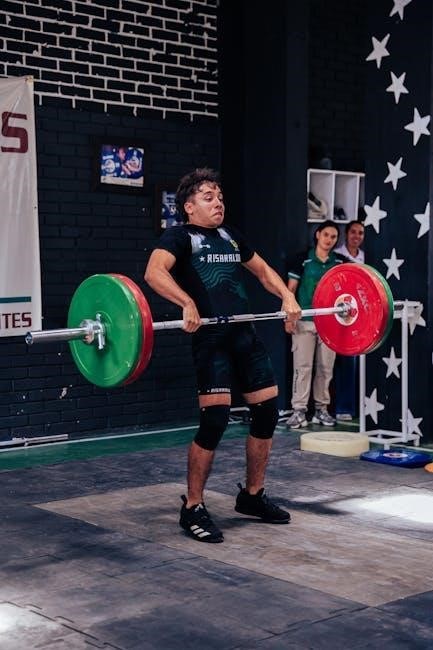
A percentage-based strength training program uses training percentages derived from your one-repetition maximum (1RM) to guide intensity‚ ensuring personalized and efficient strength development.
By focusing on progressive overload and periodization‚ this approach helps athletes achieve consistent gains while minimizing injury risks‚ making it a cornerstone of modern strength training.
What is a Percentage-Based Training Program?
A percentage-based training program structures workouts using percentages of an individual’s one-repetition maximum (1RM) for specific exercises. This approach allows for personalized intensity levels‚ ensuring exercises are tailored to the lifter’s current strength. By basing training on percentages‚ the program enables progressive overload and periodization‚ which are key for consistent strength gains. It also provides a clear framework for adjusting weights and intensity‚ making it adaptable to different fitness levels and goals. This method is widely used in strength training as it offers a scientific and structured way to track progress and optimize performance over time.
Importance of Percentage-Based Training for Strength Development
Percentage-based training is crucial for strength development as it ensures workouts are tailored to an individual’s current strength level‚ promoting progressive overload safely. By using percentages of one-repetition maximum (1RM)‚ lifters can maintain consistent intensity‚ which is essential for muscle adaptation. This approach minimizes the risk of injury by preventing excessive loads that might lead to improper form. It also allows for periodization‚ enabling athletes to peak at specific times while avoiding plateaus. For intermediate to advanced athletes‚ percentage-based programs are particularly effective‚ as they provide a structured path for continuous improvement. This method ensures that strength gains are measurable‚ consistent‚ and aligned with long-term goals.

Understanding Training Percentages
Training percentages are reference numbers based on a lifter’s 1RM‚ guiding intensity for specific exercises. They help assign load percentages‚ ensuring periodized programs match strength levels and goals‚ optimizing progress while minimizing injury risks through structured intensity.
What are Training Percentages and How are They Calculated?
Training percentages are reference numbers based on a lifter’s one-repetition maximum (1RM)‚ used to determine exercise intensity. They are calculated by dividing the desired weight by the 1RM and multiplying by 100. For example‚ lifting 200 pounds at 80% intensity means 200 = 80% of 1RM (1RM = 250 pounds). These percentages guide program design‚ ensuring workouts align with strength levels and goals. A training load chart can also assign intensity percentages‚ such as those based on reps (e.g.‚ 70% for 8-10 reps). This system allows for precise and periodized programming‚ optimizing strength gains while minimizing injury risks‚ as supported by research in the NSCA Journal.
Role of One Repetition Maximum (1RM) in Percentage-Based Training
The one-repetition maximum (1RM) is the foundation of percentage-based training‚ representing the maximum weight an individual can lift for one repetition of an exercise. It serves as a baseline for calculating training percentages‚ allowing for personalized and scalable programming. By determining the 1RM for key lifts‚ athletes can assign specific intensities (e.g.‚ 70%‚ 80%) to their workouts‚ ensuring exercises align with their current strength levels. This approach enables progressive overload by gradually increasing weights while maintaining proper form. The 1RM also helps minimize injury risks by providing clear guidelines for intensity‚ making it a critical tool for designing safe and effective strength training programs for athletes of all levels.

Benefits of a Percentage-Based Strength Training Program
A percentage-based program enhances training efficiency by tailoring intensities to individual strength levels‚ promoting consistent progress and reducing injury risks through structured progressive overload.
Increased Training Efficiency and Consistency
A percentage-based program optimizes training efficiency by aligning intensity with individual strength levels‚ ensuring workouts are neither too light nor excessively demanding. By using percentages of one-repetition maximum (1RM)‚ lifters can precisely control the intensity‚ leading to consistent progress. This approach minimizes wasted effort and prevents plateaus‚ as the program adapts dynamically to the lifter’s current capacity. Progressive overload is implemented systematically‚ allowing for steady strength gains without overreaching. The structured nature of percentage-based training also reduces the risk of injury by maintaining proper form and avoiding excessive fatigue. This method ensures that every workout contributes meaningfully to long-term strength development‚ making it a highly effective and sustainable training strategy.
Personalization Based on Individual Strength Levels
A percentage-based strength training program allows for exceptional personalization‚ as it tailors intensities to each individual’s current strength level. By using percentages of one-repetition maximum (1RM)‚ the program adapts to the lifter’s unique capabilities‚ ensuring that the workload is appropriate and effective. This approach eliminates the one-size-fits-all mentality‚ enabling lifters of all experience levels to benefit equally. Personalization also reduces the risk of plateaus‚ as the program naturally adjusts as strength improves. This tailored method fosters greater engagement and motivation‚ as lifters can clearly track their progress and adjust their training accordingly. It ensures that every individual maximizes their potential for strength gains.
Reduced Risk of Injury Through Progressive Overload
A percentage-based strength training program minimizes injury risk by implementing progressive overload‚ where weights are gradually increased based on current strength levels. This method prevents sudden‚ excessive loads that can strain muscles and joints. By working within specific percentage ranges tied to one-repetition maximum (1RM)‚ lifters avoid unnecessary stress on their bodies. Progressive overload also encourages proper form and technique‚ as lifters master lighter weights before advancing. This structured approach reduces the likelihood of overtraining and ensures sustainable strength gains. Over time‚ this method strengthens connective tissues and muscles‚ further lowering the risk of injury and promoting long-term durability in training.

Designing a Percentage-Based Strength Training Program
Designing a percentage-based program involves calculating 1RM‚ structuring training phases‚ and selecting exercises based on strength goals and progression plans for optimal results.
How to Determine Your 1RM for Key Lifts
To determine your one-rep maximum (1RM) for key lifts‚ you can use either a direct or submaximal test. The direct method involves attempting to lift the maximum weight possible for one repetition‚ which is best for experienced lifters. For those newer to strength training or seeking a safer approach‚ the submaximal test is recommended. In this method‚ you lift a known weight for a specific number of repetitions‚ then use a formula or online calculator to estimate your 1RM. For example‚ if you can lift 100 pounds for 10 reps‚ your 1RM might be estimated at around 133 pounds. Prioritize proper form and recovery between attempts to ensure accuracy and safety. Regularly reassessing your 1RM helps adjust training percentages and track progress effectively.
Creating a Sample Training Program Based on Percentages
A sample percentage-based training program might involve a 4-day split‚ focusing on major lifts like the squat‚ bench press‚ deadlift‚ and overhead press. For example‚ Day 1 could include squats at 70% 1RM for 5 sets of 5 reps and bench presses at 75% 1RM for 4 sets of 6 reps. Day 2 might focus on deadlifts at 65% 1RM for 4 sets of 5 reps and pull-ups at 80% 1RM for 3 sets of 8 reps. Accessory work‚ such as lunges or rows‚ can be added at lower percentages (60-70%) for higher reps (8-12). This structure allows for progressive overload while maintaining technique and recovery.
Periodization Strategies in Percentage-Based Training
Periodization involves structuring training into phases to optimize strength gains and prevent plateaus. A linear periodization model gradually increases training percentages over time‚ while block periodization alternates between intensity and volume phases. For example‚ a 12-week program might start with 70% 1RM for 4 sets of 8 reps‚ progressing to 80% 1RM for 5 sets of 5 reps. Deload weeks‚ where percentages are reduced by 10-15%‚ are included every 4-6 weeks to aid recovery. This strategic approach ensures continuous progress‚ prevents overtraining‚ and aligns with individual goals‚ making it a cornerstone of effective percentage-based training programs.

Role of Progressive Overload in Percentage-Based Training
The role of progressive overload in percentage-based training involves systematically increasing weights or reps to drive strength gains‚ ensuring continued progress and muscle adaptation over time effectively.
How to Gradually Increase Training Intensity
To gradually increase training intensity in a percentage-based program‚ start by incrementing the weight lifted by small percentages (2.5%-5%) each week or cycle. This allows for consistent progress without overreaching. Additionally‚ increase the number of repetitions or sets at the same percentage of 1RM to build volume and strength. Another method is to decrease rest periods between sets or increase the frequency of training sessions. These adjustments ensure progressive overload is applied systematically‚ promoting continuous strength gains while minimizing the risk of plateau or injury. The key is to make incremental changes based on individual recovery and performance.
When and How Often to Adjust Training Percentages
Training percentages should be adjusted based on consistent strength improvements or plateaus. A good rule of thumb is to increase the weight by 2.5%-5% every 4-6 weeks if you’re completing all sets with good form. If progress stalls‚ reduce the percentage by 2.5%-5% to allow recovery and rebuilding. Adjustments should also consider recovery‚ as excessive fatigue may require a temporary decrease. Regularly testing your 1RM ensures percentages remain accurate. Avoid frequent changes; consistency is key for progressive overload. Adjustments should align with periodization phases‚ such as deload weeks‚ to maintain long-term progress and prevent overtraining.

Exercise Selection for a Percentage-Based Program
Exercise selection should prioritize compound movements like squats and deadlifts‚ as they effectively build overall strength. Accessory exercises support muscle balance and prevent injuries‚ enhancing overall development.
Compound Movements and Their Importance
Compound movements‚ such as squats‚ deadlifts‚ bench presses‚ and pull-ups‚ are foundational to percentage-based strength training. These exercises engage multiple joints and muscle groups simultaneously‚ making them highly efficient for building overall strength and muscle mass. They mimic real-world movements‚ improving functional fitness and athletic performance. By targeting major muscle groups‚ compound lifts enhance neuromuscular coordination and promote balanced development. In a percentage-based program‚ these movements allow for precise loading and progression‚ ensuring consistent strength gains. They also provide a reliable measure of progress‚ as increases in lift percentages directly reflect improved strength. Prioritizing compound movements ensures a structured and effective approach to strength development.
Accessory Exercises to Support Strength Development
Accessory exercises play a crucial role in supporting strength development within a percentage-based training program. These exercises target smaller muscle groups and movement patterns that may not be fully engaged during compound lifts. Examples include lunges‚ pull-ups‚ and dumbbell presses. They help address muscle imbalances‚ improve joint stability‚ and enhance overall athleticism. Accessory exercises also promote recovery by reducing the risk of overtraining from heavy compound movements. By incorporating them at lower percentages of 1RM‚ lifters can focus on muscle endurance and hypertrophy without compromising the intensity of their main lifts. This balanced approach ensures comprehensive strength and muscle development‚ complementing the primary compound movements effectively.

Tracking Progress in a Percentage-Based Program
Regularly monitor strength gains by tracking lifts and adjusting percentages. Use training logs to record progress‚ ensuring consistency and gradual overload. Maintain proper form throughout.
How to Monitor Strength Gains Over Time
Regularly assess strength improvements by periodically testing one-rep max (1RM) for key lifts or using submaximal efforts to estimate progress. Track workout logs to document completed lifts‚ weights‚ and repetitions. Measure progress by observing increases in training percentages over time. Consistency in tracking allows for data-driven decisions to adjust training programs. Use progress photos or body composition measurements as secondary indicators of strength gains. Celebrate small achievements to stay motivated and ensure training remains challenging yet sustainable. Over time‚ gradual increases in lift percentages indicate successful strength development.
Using Training Logs for Effective Program Adjustments
Maintaining detailed training logs is essential for tracking progress and making informed adjustments to a percentage-based program. Log each workout‚ noting the weight‚ repetitions‚ and rest periods for every exercise. This data helps identify trends‚ such as increases in strength or potential plateaus. Regularly review logs to determine if training percentages need adjustment or if recovery strategies should be modified. Over time‚ logs reveal patterns in strength gains‚ allowing for precise program tweaks. Use this information to increase weights‚ adjust volume‚ or incorporate new exercises. Consistent logging ensures accountability and provides a clear roadmap for optimizing your training journey.

Common Mistakes to Avoid in Percentage-Based Training
Common mistakes include neglecting individual strength levels‚ failing to adjust percentages as strength increases‚ and inconsistent tracking‚ which can hinder progress and lead to plateaus.
Overreliance on Fixed Percentages Without Considering Recovery
One common mistake in percentage-based training is relying too heavily on fixed percentages without accounting for recovery. While percentages provide structure‚ they don’t account for daily fluctuations in energy and readiness. Ignoring recovery can lead to overtraining‚ decreased performance‚ and increased injury risk; Lifters may push through fatigue‚ compromising form and progression. It’s essential to balance strict percentage adherence with listening to your body. Recovery needs vary based on factors like sleep‚ stress‚ and nutrition. A rigid approach can hinder long-term gains‚ so it’s crucial to allow for adjustments based on recovery status while maintaining progressive overload.
Ignoring Proper Form and Technique
Ignoring proper form and technique is a significant mistake in percentage-based strength training. While focusing on percentages can enhance intensity‚ poor form compromises both safety and effectiveness. Exercises performed with improper technique can lead to injuries‚ as they place unnecessary strain on joints and muscles. Additionally‚ poor form reduces the effectiveness of the exercise‚ as the intended muscle groups may not be engaged optimally. Consistency in form is crucial for tracking progress and ensuring that strength gains are achieved safely. Coaches and lifters must prioritize proper technique‚ even if it means temporarily reducing weights to maintain form. Sacrificing form for heavier loads undermines long-term progress and increases injury risk‚ making it a critical error to avoid in any training program.

Role of Nutrition and Recovery in Percentage-Based Training
Nutrition and recovery are critical for optimizing percentage-based training. Proper fueling ensures energy for intense workouts‚ while recovery supports muscle repair and growth‚ enhancing overall performance and strength gains.
Nutritional Strategies to Support Strength Gains
A well-structured diet is essential for maximizing strength gains in a percentage-based training program. Focus on consuming sufficient protein (1.6-2.2g per kg of body weight) to support muscle repair and growth. Carbohydrates should comprise the bulk of calorie intake‚ providing energy for intense workouts. Healthy fats‚ particularly from sources like avocados and nuts‚ are vital for hormone production. Adequate caloric intake is crucial‚ with a slight surplus for bulking or a controlled deficit for cutting. Hydration is equally important‚ as even mild dehydration can impair performance. Timing meals around workouts‚ such as a pre-workout meal rich in carbs and protein‚ can enhance training quality. A balanced diet ensures sustained energy and optimal recovery.
Importance of Sleep and Recovery for Optimal Results
Sleep and recovery are critical for strength gains in a percentage-based training program. During sleep‚ the body repairs and adapts muscles‚ solidifying strength improvements. Aim for 7-9 hours of quality sleep nightly to support muscle recovery and hormonal balance. Poor sleep quality can hinder progress‚ reducing strength and increasing fatigue. Additionally‚ incorporate rest days to allow muscles to recover between intense training sessions. Active recovery techniques‚ such as light cardio or mobility work‚ can enhance blood flow without overtaxing the body. Prioritizing sleep and recovery ensures the body adapts effectively to the demands of percentage-based training‚ leading to consistent strength improvements over time.

Sample Training Program Based on Percentages
A structured program with specific intensity‚ volume‚ and frequency based on percentages of 1RM. Includes focused days for compound lifts and accessory exercises.
Day 1: Squat and Press Focus
Begin with a dynamic warm-up focusing on lower body mobility and shoulder activation. Perform 4 sets of 5 reps at 70% 1RM for back squats‚ followed by 4 sets of 4 reps at 75% 1RM for overhead presses. Include accessory work like front squats (3×6 @ 65% 1RM) and push presses (3×5 @ 70% 1RM). Finish with core exercises such as plank variations or Russian twists. Ensure proper form throughout and adjust percentages based on current strength levels. Rest for 60-90 seconds between sets and 120-180 seconds between exercises. End with a cool-down routine to promote recovery.
Day 2: Deadlift and Bench Press Focus
Start with a dynamic warm-up targeting hamstrings‚ hips‚ and shoulders. Perform 5 sets of 4 reps at 75% 1RM for conventional deadlifts‚ followed by 5 sets of 5 reps at 70% 1RM for flat bench presses. Include accessory exercises like Romanian deadlifts (4×6 @ 65% 1RM) and incline bench presses (4×5 @ 70% 1RM). Add pull-ups or lat pulldowns for upper back development. Rest for 60-90 seconds between sets and 120-180 seconds between exercises. Finish with a cool-down‚ including stretching and foam rolling to aid recovery. Adjust percentages based on current strength and ensure proper form throughout the workout.
Day 3: Accessory and Conditioning Work
Begin with a light warm-up‚ such as 5-10 minutes of cardio and dynamic stretching. Perform 4 sets of 8-12 reps for pull-ups or lat pulldowns at 60-70% 1RM. Follow with 4 sets of 10-12 reps for dumbbell rows at 65% 1RM. Include core exercises like planks (3×60 seconds) and Russian twists (4×15 per side). Finish with conditioning‚ such as 20-30 minutes of rowing or cycling at 70-75% effort. Rest for 60-90 seconds between sets and 120-180 seconds between exercises. Adjust percentages based on recovery and strength levels. Focus on maintaining proper form and pacing to optimize performance and recovery.
A percentage-based strength training program offers consistency‚ personalization‚ and injury prevention.Monitor progress‚ adjust percentages‚ and stay patient for optimal results over time.
Final Thoughts on Implementing a Percentage-Based Program
Implementing a percentage-based strength training program requires consistency and patience. By focusing on individualized percentages and progressive overload‚ lifters can achieve sustainable strength gains. Monitoring progress through training logs ensures accountability and guides necessary adjustments. It’s crucial to balance intensity with recovery to avoid plateaus or injuries. Proper nutrition and sleep further support the effectiveness of the program. Over time‚ lifters will notice improvements in both strength and overall performance. Stay committed to the program‚ and celebrate small victories along the way to maintain motivation. Remember‚ strength development is a long-term journey‚ and consistency is key to reaching your goals.
Encouragement to Adapt and Evolve the Program
Embrace the flexibility of a percentage-based program by adapting it to your unique needs and goals. Recognize that strength training is not a one-size-fits-all approach—each lifter’s journey is different. Periodically reassess your 1RM to ensure percentages remain accurate and challenging. Incorporate variety by adjusting rep ranges or accessory exercises to prevent plateaus. Stay attentive to your body’s signals‚ tweaking intensities or volumes as needed. Celebrate progress‚ no matter how small‚ to maintain motivation. Remember‚ the program is a framework‚ not a rigid blueprint. By evolving and adapting‚ you’ll ensure long-term success and continued strength development.

